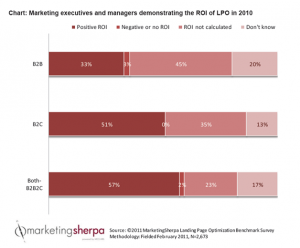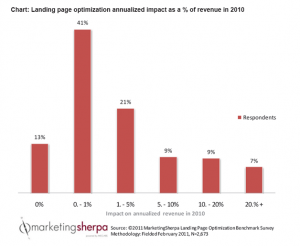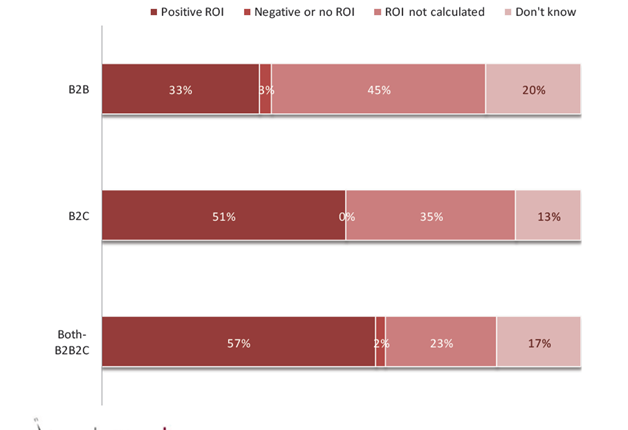Marketing Campaign: Landing page optimization can help improve the return on your media spend
Let’s take a quick look at the typical marketing funnel in 2011 to see how you can improve your results. If you’re like the average marketer, you spend a lot of money on media, such as:
- Broadcast TV ads
- Newspaper ads
- Magazine ads
- Outdoor advertising, such as billboards and transit advertising
- Radio ads
- Internet advertising, such as banner ads and pay-per-click ads
In fact, marketers spent $238 billion in just the first six months of 2010, according to Nielsen.
Why do companies spend so much on advertising?
That’s a lot of loot. And, of course, marketers are spending that money to sell a product. However, they aren’t truly selling a product or service at all … they’re actually spending that money to drive customers to a landing page. In fact, according to Econsultancy, 65% of all UK print and television advertising now includes a Web address.
Even when the ad don’t specifically include a URL, ad-inspired branded searches drive many customers to a website as the next logical point of contact.
In other words, you’re spending a lot of dough to funnel traffic to your landing pages.
If you’re a long-time reader of the MarketingExperiments blog, you already know about the power of LPO and you might as well stop reading now because I’m not going to share anything new today (although, feel free to forward this post to your boss, colleagues, and mother to show the value of what you do every day).
However, if you are looking to improve the performance of your marketing campaign and are not yet familiar with landing page optimization, I hope you’re starting to see why this practice can have such an impressive ROI.
Essentially, if you’re spending all of this money to drive potential customers to a website, investing just a little in increasing conversion on that site (more sales, more leads, etc.) can have an outsize impact, as you can see in this research from the MarketingSherpa 2011 Landing Page Optimization Benchmark Report:

After all, the deeper into the funnel you improve performance, the bigger an impact it has.
So what is landing page optimization exactly?
Landing page optimization, or LPO, is just one term for the process I’m about to describe. You might also hear marketers discuss optimization, Web design or redesign, conversion optimization, conversion rate optimization (CRO), usability, or UX/UI.
The general process is simple to explain, but much more difficult to execute on:
- Step #1: Identify possible changes on your site that could improve the conversion of the traffic you’re paying good money to send to your website. Essentially, form a hypothesis about what you can change, and what you can learn from that change.
- Step #2: Test to see what you can learn from your audience. Unlike focus groups or surveys, valid tests will tell you with their real-world, real-time action if the changes you made helped improve conversion, had no effect, or decreased conversion. It’s important to note that you might hear marketers refer to this testing by many names as well, such as A/B testing, landing page testing, conversion rate testing, usability testing, split testing or UX/UI testing.
- Step #3: Learn from these tests. The results from these tests will tell you something about your audience. This is, essentially, the heart of evidence-based marketing. You can do more than use this information to improve your landing pages and home page to better convert on all that traffic you’re investing so much money in to send there. You can also use this new business intelligence to better serve your customers with products and services that more accurately serve their needs (and, of course, better products and services are easier to sell). But it will take more than just one test …
- Step #4: True LPO requires a testing-optimization cycle. You must continually repeat the above steps. One test, by its nature, only gives you a limited view into what your customers and prospective customers want. But continually testing and learning and improving is, essentially, what landing page optimization is, and it will help you, as the very definition of the word optimize implies, “get the most use out of” your entire marketing spend.
Where to begin?
If you’re new to landing page optimization, you might immediately see the value, but it can be a daunting task. And after all, you’re likely a very busy marketer with little time for new tasks.
Keep in mind this one last upside. Not only will landing page optimization help you improve your marketing budget’s return, LPO will help you prove your value to your boss, your client, your CMO, your CEO, your board or anyone else you report to.
By testing and measuring the impact or your changes, you gain hard data that shows, well, your impact. And how big of an impact might that be on your company’s revenue? Here’s some more research from the MarketingSherpa 2011 Landing Page Optimization Benchmark Report:

You can start by taking a look at the MarketingExperiments website or signing up for our email list. We have a lot valuable, free information dedicated to landing page optimization and testing.
Also, MarketingExperiments’ sister company, MarketingSherpa is currently holding a contest on its Facebook page that can help you with first step of the above process. Just “Like” the page for a chance to win a LPO session with a MarketingExperiments’ research analyst.
Related resources:
Optimization Summit 2012: Call for Speakers
Landing Page Design: Eye path vs. Thought sequence
Landing Page Optimization: 36 articles and resources to help you complete your next LPO project
Landing Page Optimization: Minimizing bounce rate with clarity




In our case, it is kind of difficult to optimize for most of what we sell, except our training programs (we’ve just started those, so maybe LPO would fit for that).
We mostly want to be highly visible and foster trust and reliability through our online presence, which will then make people want to call us so they can continue this relationship and become a client. It is a very long term marketing plan, which doesn’t quite fit with the landing page paradigm. We are a marketing agency so we have a few big clients and a spattering of smaller ones.